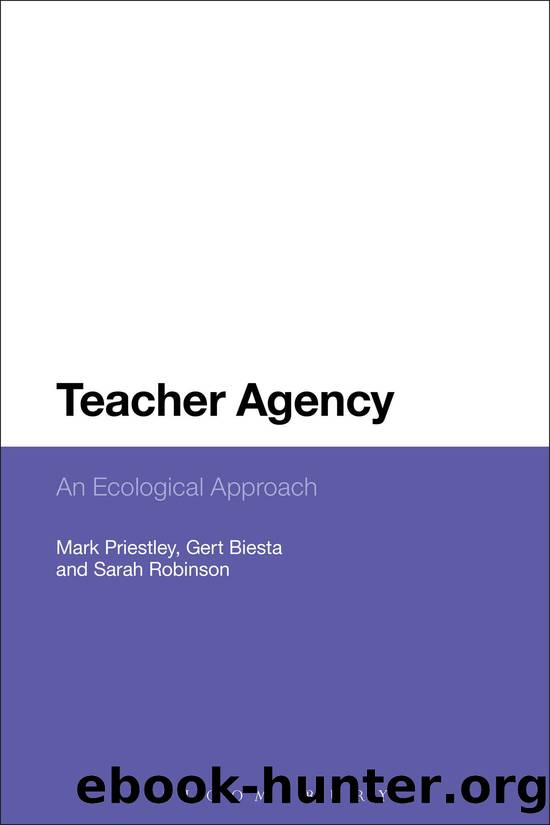Teacher Agency by Mark Priestley;Gert Biesta;Sarah Robinson; & Gert Biesta & Sarah Robinson

Author:Mark Priestley;Gert Biesta;Sarah Robinson; & Gert Biesta & Sarah Robinson
Language: eng
Format: epub
Publisher: Bloomsbury UK
Commonalities
The purpose of this section is to briefly highlight a number of commonalities among the teachers, illustrating that in many key respects, there was a relatively common baseline for their achievement of agency.
As mentioned earlier, three of the four teachers in the secondary schools had prior experience of working in careers outside of teaching, potentially allowing them to draw on wide experiences in framing their teaching. In each case, we were impressed by the level of commitment to their work. All of the teachers admitted to working in the evenings and sometimes at weekends; preparing lessons, marking and assessing as well as reporting. All of them were highly active participants in the wider civic society of their schools. They each had experience of leading and/or developing initiatives focused on the development of new forms of pedagogy. Each had experience of involvement in whole-school initiatives, for example, working parties to develop aspects of the curriculum. In one case, the teacher had gone beyond this school-level activity, having been regularly involved in national working parties to develop assessment and the curriculum.
Another common strand lay in their strong focus on classroom teaching as a vocation. The four teachers were all enthusiastic about teaching and moreover showed little interest in developing their careers into management positions. One of the teachers had undertaken a temporary role as a faculty leader and experienced discomfort in this role. Another was actively, at the time of the research, resisting pressure from a senior colleague to apply for management positions. All of these teachers were thus characterized by a strong desire to work with students in classrooms.
All of the four teachers articulated a strong commitment to their students and especially to their roles as teachers of the whole child rather than just deliverers of content. These teachers were quite eclectic in their teaching approaches; they all expressed a liking for student-centred, dialogical and active pedagogy, while being equally comfortable with more didactic forms of pedagogy. Student learning was central to their work, and while student attainment was clearly important to them, their teaching was not narrowly focused on this. The teachers clearly cared about their students and highlighted the importance of establishing good relationships with them. One teacher expressed it as follows:
Iâm a firm believer in that so much of teaching is about relationships. You could be the most clued up person in the world about your subject. But if you canât relate to the kids, if you canât engage with them as people, then thatâs your problem. You are not going to make them enthusiastic. You are not going to make them interested because the relationship isnât there. [Sara]
Such sentiments were common to all four of the teachers, all of whom expressed commitment to strong educational values centred on what they described as âdeveloping and encouraging the individual pupilâs learning.â One teacher planned to come to work even when suffering a debilitating injury, as she thought that her duty lay with teaching students. This teacher exhibited in her work what has been termed âprotective mediationâ (Osborn et al.
Download
This site does not store any files on its server. We only index and link to content provided by other sites. Please contact the content providers to delete copyright contents if any and email us, we'll remove relevant links or contents immediately.
Navigation and Map Reading by K Andrew(4893)
Spare by Prince Harry The Duke of Sussex(4804)
Tuesdays with Morrie by Mitch Albom(4411)
Cracking the GRE Premium Edition with 6 Practice Tests, 2015 (Graduate School Test Preparation) by Princeton Review(4053)
Machine Learning at Scale with H2O by Gregory Keys | David Whiting(3660)
What It Really Takes to Get Into Ivy League and Other Highly Selective Colleges by Hughes Chuck(3561)
Never by Ken Follett(3549)
Goodbye Paradise(3460)
Harry Potter and the Prisoner of Azkaban (Book 3) by J. K. Rowling(3123)
Pledged by Alexandra Robbins(3052)
Kick Ass in College: Highest Rated "How to Study in College" Book | 77 Ninja Study Skills Tips and Career Strategies | Motivational for College Students: A Guerrilla Guide to College Success by Fox Gunnar(3003)
Fairy Tale by Stephen King(2967)
A Dictionary of Sociology by Unknown(2862)
Sapiens and Homo Deus by Yuval Noah Harari(2857)
Reminders of Him: A Novel by Colleen Hoover(2780)
The Social Psychology of Inequality by Unknown(2774)
Graduate Admissions Essays, Fourth Edition: Write Your Way into the Graduate School of Your Choice (Graduate Admissions Essays: Write Your Way Into the) by Asher Donald(2743)
Get into Any College by Tanabe Gen Tanabe Kelly(2634)
Zero to Make by David Lang(2634)
